|
What is a Fisheries Stock Assessment?
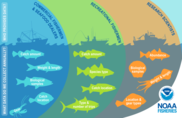
Stock assessments describe the historical state of a fish population, current numbers of young and mature fish in the population, how many fish die from natural causes or fishing, and how the population may change in the future. But how does an assessment work and what goes into it? Stock Assessments are informed by significant input and data from commercial fishermen and fish dealers, recreational fishermen, research scientists, and more. Together, this information helps us develop our stock assessments, which in turn helps us determine sustainable harvest levels for each fish stock.
|
Scientists Look at Dams and Atlantic Salmon Survival
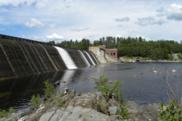
NOAA Fisheries Atlantic salmon researchers have found that Atlantic salmon abundance can increase as more young fish and returning adults survive their encounters with dams. Also, progress in rebuilding the population will depend heavily on continued stocking using hatchery fish raised especially for this purpose. This conclusion is based on a life history model and new information on changes in the Penobscot River watershed.
|
Field Testing New Data Collection Systems

This month our Cooperative Research Branch will test a new data collection system for use on the Gulf of Maine Bottom Longline Survey. The system will integrate wireless electronic length boards, motion-compensated digital scales, barcode scanners, and label printers into one application running on a rugged tablet. Researchers and crew will perform some initial tests at the dock and then each vessel will conduct day trips. During testing, staff will identify and address bugs, and document new protocols. The new data collection system is a step forward in how we collect fisheries survey data that ultimately support our nation's fisheries.
|
Stock Assessment Updates
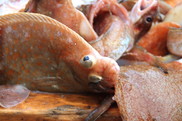
From September 14-18, 2020, there will be a peer review for groundfish and sea scallop stock assessments. These assessments will include data through 2019. In November there will be a peer review of the results obtained by the Index-Based Methods and Control Rules Working Group, and the research that they have conducted. This working group will provide research to improve multiple assessments. The Haddock Working Group has been formed and will begin working on assessments for three haddock stocks, including one shared with Canada, to be reviewed in 2021.
|
Solving a Squid Puzzle
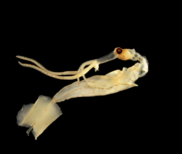
The long-held mystery of how many squid species occur in the Northwestern Atlantic is slowly being unraveled. Our Oceans and Climate Branch is using samples of paralarval cephalopods, or baby squids and octopuses, from as far back as the late 1970s to identify common and rarely seen species from both inshore and deep waters from the Gulf of Maine to Florida. It is difficult to identify species from just the size and shape of body parts and pigment patterns of cephalopods in this little-known life stage. We are making progress by comparing our paralarvae samples taken from the western North Atlantic Ocean with identified specimens taken elsewhere. This slow but important step in understanding the diversity and distribution of both commercially important species and oceanic taxa will help us understand the oceanic food web for many fish, seabirds, and marine mammals.
|
Loggerhead Sea Turtles Record a Passing Hurricane
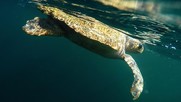
Since 2009, our science center has teamed up with the Coonamessett Farm Foundation to tag more than 200 loggerheads in the Mid-Atlantic Bight. With 10 years of data, researchers can now get a deeper understanding of how turtles behave and what environmental factors drive them. They can also look back at the data and ask new questions, as they did in this study. In 2011, 18 of their satellite-tagged loggerhead turtles were caught in Hurricane Irene. Data from the tags allowed researchers to track changes in their behavior as well as get an inside look at what happens in the water column under hurricane conditions.
|
Kiersten Curti Spotlight on Stock Assessments

This proud Pittsburgher has always enjoyed STEM fields. What in particular drew Kiersten to fisheries science? It was its applied nature—science driven by an explicit need with direct impacts. Meet Kiersten Curti, research fishery biologist in our Population Dynamics Branch located at our Woods Hole Laboratory in Woods Hole, Massachusetts.
|
Andy Jones Connects Scientists and Fishermen

Andy joined our Cooperative Research Branch as fishery biologist back in March. He now leads the branch's research projects that depend on working directly with the fishing industry. His goal is to advance the application and usefulness of data the branch collects with commercial fishermen. He also wants to develop new projects that can address scientific and fishing industry needs.
|
|
|
Upcoming Events
COVID-19: We continue to plan events, but they may be delayed, cancelled, or moved to a virtual platform closer to their date.
Sept 7 Office of National Marine Sanctuaries “Get Into Your Sanctuaries” Photo Contest
Sept 15 Dr. Nancy Foster Habitat Conservation Award Nomination
Sept 14-18 Fisheries Stock Assessment Peer Review, Groundfish and Sea Scallops
Sept 16 ICES global COVID-19 Fisheries Impacts Webinar
Oct 12 Sea Scallop 2021-2022 Research Set-Aside Call for Proposals
|
|
|
|